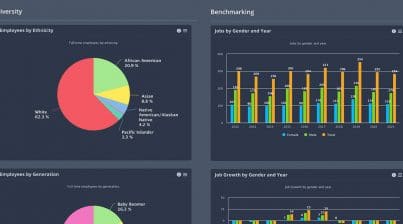Despite your best efforts, there are some workplace conflicts that are almost impossible to avoid between coworkers. As an HR professional, team manager, or leader, you need to prepare yourself to resolve conflict as quickly and efficiently as possible. What’s even better is if you can track the sources of conflict in the workplace and proactively stop them from creating problems in the first place.
Tension in the workplace can be a result of multiple factors. And if ignored, these conflicts can wreak havoc on workforce productivity, collaboration, and meeting strategic goals. Additionally, they can cause even deeper workforce issues like absenteeism and increased turnover.
Let’s identify and define common workplace conflicts. Then, we’ll offer some solutions for conflict resolution management.
What is Workplace Conflict
Conflict in the workplace is a normal occurrence in most organizations. Dictionary definitions vary from calling it a sharp disagreement to opposing ideas and interests. Wherever people work together, conflict is likely to arise in many forms.
Common Workplace Conflicts: Reasons, Types, and Signs
Leadership Style
Each team leader has their own style when it comes to management, communication, and responsibilities. Different styles of leadership can confuse employees and bring about different types of conflict in the workplace, especially during stressful periods. And leadership skills are one of the qualities of an excellent HR manager.
For example, the leader of one team may be demanding, bold, or charismatic, whereas another team leader may be more flexible, laid back, and inviting. When the time comes to collaborate on a project, their leadership styles may cause frustration.
To solve these potential conflicts, you should emphasize mutual respect of differences. Train these team leaders on how to properly interact with the work styles and personalities of people on each of the teams and adjust and connect with their employees no matter their leadership preferences.
Personality Type
Regardless of position, role, or responsibilities, personality conflicts at work are common among employees. This kind of conflict in the workplace usually occurs because of mistaken perceptions of co- workers’ attitudes and behaviors. When different personality types work together, there is an increased likelihood that a misunderstanding of each other’s motives, character, and actions will happen.
For example, if an employee is introverted, quiet, and not sociable, they might appear snobby or rude to the rest of the team. This can cause problems in their collaboration and communication, putting a damper on the team’s productivity.
Through everyday experiences, we don’t necessarily like everyone we meet. Translate that into the workplace and it’s not easy to work with someone whose personality and behaviors we find objectionable. But it’s important to remember that who we perceive someone to be is not necessarily who they are. Don’t let what you’ve seen and heard define everything you’ll think about a coworker in the future.
Responsibility Category
It’s not a unique situation, but rather a common occurrence when a person hasn’t properly carried out or completed a task at work. A typical conflict that comes out of this scenario is blame-shifting or lack of accountability. A responsible team member will answer for their actions. A neglectful person will point fingers and place the blame on someone else. This type of conflict is not always fair or even justified.
For example, your sales team doesn’t hit revenue goals for the quarter but instead of looking at shortfalls or reasons on the team, the manager blames the marketing team for not providing enough marketing resources. This isn’t the best way to handle the situation.
As a leader, it’s important that your various teams and team members understand their responsibilities, duties, goals for each quarter. And it’s important for team leaders to track progress and check-in with team members to ensure clarity of what they are trying to achieve. Make sure you are delegating tasks effectively and communicating the importance of responsibility and accountability for each team member.
Cultural and Generational Diversity
Workplace diversity is not just a favorite buzzword with human resources personnel. It should also be a desirable attribute of your organization’s culture. What comes as no surprise, however, is that when employees of different cultural or ethnic backgrounds, belonging in multiple generational groups, and having various belief systems end up being involved in conflicts. So, what is the best way to handle cultural conflicts among your workforces? Instead of focusing on the ways in which your workforce differs, remind team members of what they have in common!
However, if the conflict escalates to harassment or discrimination going on due to age, race, ethnicity, gender, political stances, or religious beliefs, then there’s a serious need for HR personnel to get involved. Your company should have explicit policies regarding no harassment, no discrimination, with the consequences to inappropriate behaviors.
Working Style
Each person has their own pace at which they complete tasks. One employee may be quick to complete tasks and carry out duties, while another employee may prefer to pay more attention to details and be more meticulous, which often requires more time. Additionally, some employees like a team environment, while others prefer working solo without a lot of input from others.
For example, conflict comes when employees don’t acknowledge ideas from others, get frustrated with the pace of different working styles, and don’t respect the importance of all styles. It takes varying ideas, attention to big picture and minute details, and different types of progress on certain responsibilities to come together for great teamwork and successfully completed projects.
As leaders, it’s critical for you to have disagreeing individuals talk to each other, collaboratively decide on one idea, and look for compromise so both employees feel listened to and valued. If further help is needed to resolve the conflict, they could approach another colleague or manager to mediate and help negotiate the discussion.
Tips To Deescalate Workplace Conflict
Your organization will inevitably experience workplace conflict. As HR professionals, leaders, and managers, you will need to tackle conflict head-on. Whether the conflict is between employees or you and an employee, understanding how best to deescalate and solve the conflict is key. Here are four tips you can follow to deescalate and resolve conflict.
- Listen to all points of view and learn the facts. Take each person involved and speak to them privately to learn their concerns and dig down until you determine the source cause for the conflict.
- Determine if the conflict involves bullying, discrimination, or harassment. Work with HR to determine the best course of action if the conflict is more severe.
- Work to build a united team. Bring your staff together to try team building activities to promote unity and camaraderie.
- Find positive solutions, rather than pointing out faults. It’s best to focus on resolving conflict with positive steps forward.
In addition to coaching, consulting, and leadership development training to help reduce workplace conflicts, join us on LinkedIn to network with peers to discuss further!
How information plays a role in de-escalating workplace conflict
Knowledge really is power in the workplace – especially when conducting evaluations and trying to understand how to help employees avoid workplace conflict. Whether there is a difference of opinion or a misunderstanding about a team directive, gathering information about your workforce and being able to easily manage that data in a productive way will help HR professionals better work with teams to support communication and positive workforce behavior.
Having data at your fingertips is essential and working with an HR data dashboard like Employee Cycle can help you not only use data to anticipate issues in the workplace but also help you objectively rectify them. Give Employee Cycle a try today and schedule a demo to see for yourself how easy it is to unify multiple HR data sources and support your team’s goals and morale.












